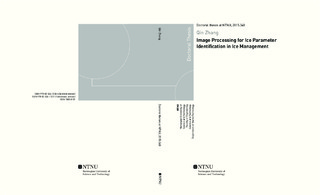| dc.description.abstract | Various types of remotely sensed data and imaging technology will aid the
development of sea-ice observation to, for instance, support estimation of ice
forces critical to Dynamic Positioning (DP) operations in Arctic waters. The
use of cameras as sensors for offshore operations in ice-covered regions will
be explored for measurements of ice statistics and ice properties, as part of a
sea-ice monitoring system. This thesis focuses on the algorithms for image
processing supporting an ice management system to provide useful ice information
to dynamic ice estimators and for decision support. The ice information
includes ice concentration, ice types, ice floe position and floe size distribution,
and other important factors in the analysis of ice-structure interaction in an ice
field.
The Otsu thresholding and k-means clustering methods are employed to identify
the ice from the water and to calculate ice concentration. Both methods
are effective for model-ice images. However, the k-means method is more effective
than the Otsu method for the sea-ice images with a large amounts of
brash ice and slush.
The derivative edge detection and morphology edge detection methods are
used to try to find the boundaries of the ice floes. Because of the inability
of both methods to separate connected ice floes in the images, the watershed
transform and the gradient vector flow (GVF) snake algorithm are applied.
In the watershed-based method, the grayscale sea-ice image is first converted
into a binary image and the watershed algorithm is carried out to segment the
image. A chain code is then used to check the concavities of floe boundaries.
The segmented neighboring regions that have no concave corners between
them are merged, and over-segmentation lines are removed automatically.
This method is applicable to separate the seemingly connected floes
whose junctions are invisible or lost in the images.
In the GVF snake-based method, the seeds for each ice floe are first obtained
by calculating the distance transform of the binarized image. Based on these
seeds, the snake contours with proper locations and radii are initialized, and
the GVF snakes are then evolved automatically to detect floe boundaries and
separate the connected floes. Because some holes and smaller ice pieces may
be contained inside larger floes, all the segmented ice floes are arranged in
order of increasing size after segmentation. The morphological cleaning is
then performed to the arranged ice floes in sequence to enhance their shapes,
resulting in individual ice floes identification. This method is applicable to
identify non-ridged ice floes, especially in the marginal ice zone and managed ice resulting from offshore operations in sea-ice.
For ice engineering, both model-scale and full-scale ice will be discussed. In
the model-scale, the ice floes in the model-ice images are modeled as square
shapes with predefined side lengths. To adopt the GVF snake-based method for
model-ice images, three criteria are proposed to check whether it is necessary
to reinitialize the contours and segment a second time based on the size and
shape of model-ice floe. In the full-scale, sea-ice images are shown to be
more difficult than the model-ice images analyzed. In addition to non-uniform
illumination, shadows and impurities, which are common issues in both sea-ice
and model-ice image processing, various types of ice (e.g., slush, brash, etc.),
irregular floe sizes and shapes, and geometric distortion are challenges in seaice
image processing. For sea-ice image processing, the “light ice” and “dark
ice” are first obtained by using the Otsu thresholding and k-means clustering
methods. Then, the “light ice” and “dark ice” are segmented and enhanced
by using the GVF snake-based method. Based on the identification result,
different types of sea-ice are distinguished, and the image is divided into four
layers: ice floes, brash pieces, slush, and water. This then makes it possible
to present a color map of the ice floes and brash pieces based on sizes. It
also makes it possible to present the corresponding ice floe size distribution
histogram. | nb_NO |
